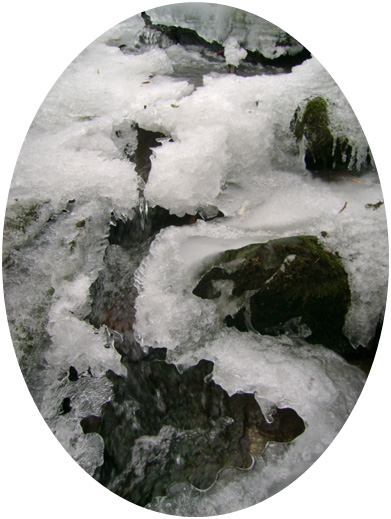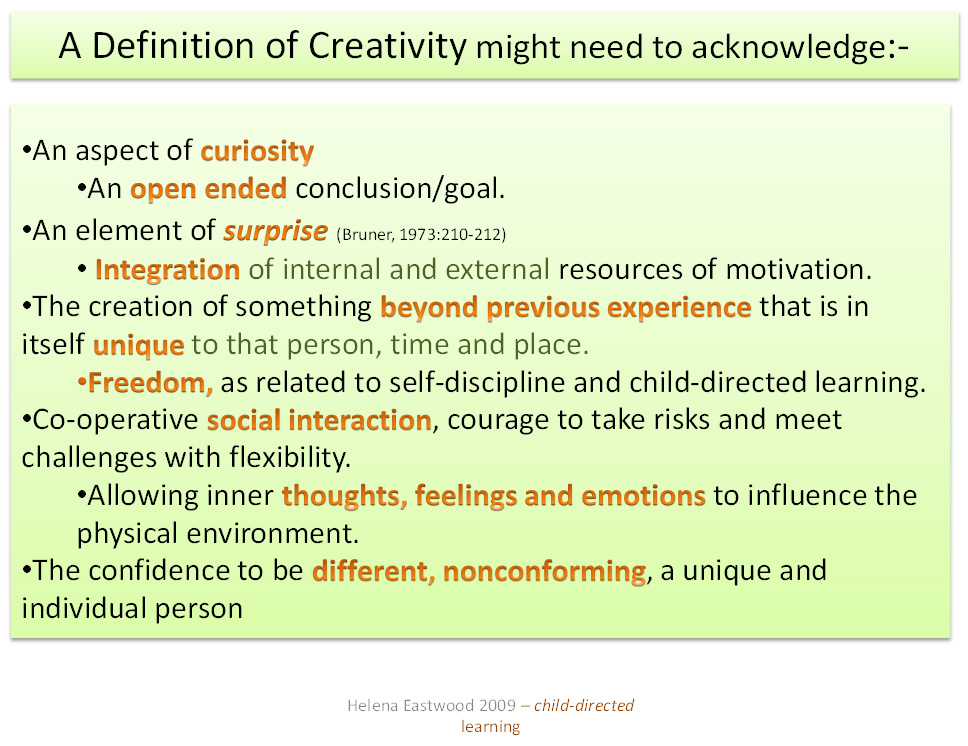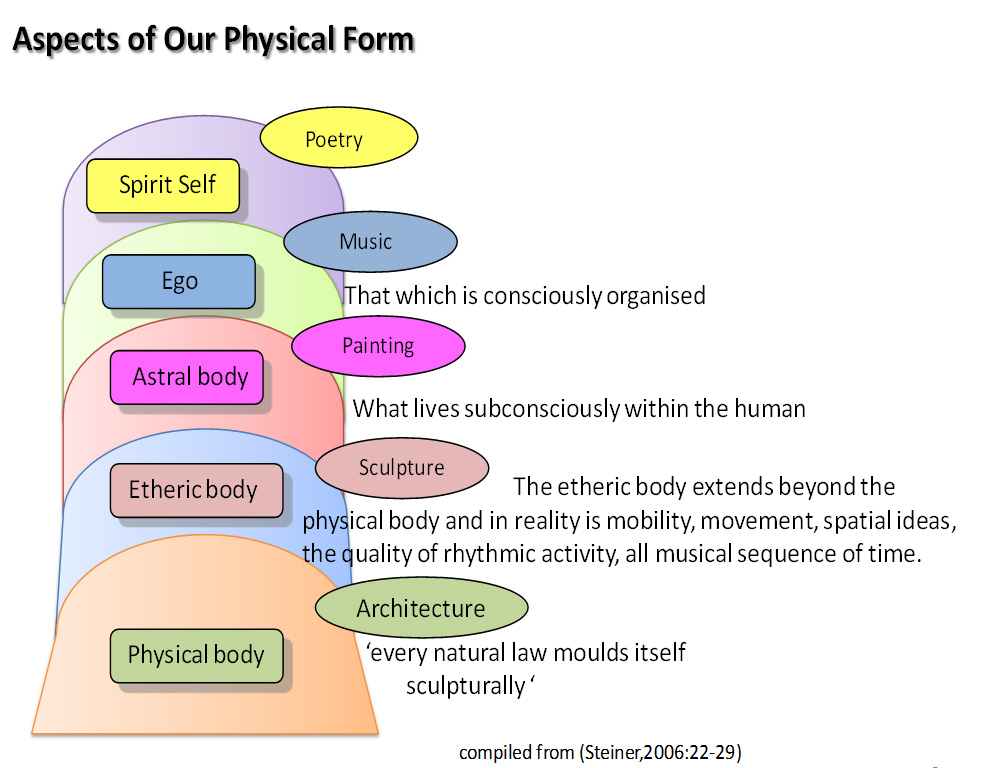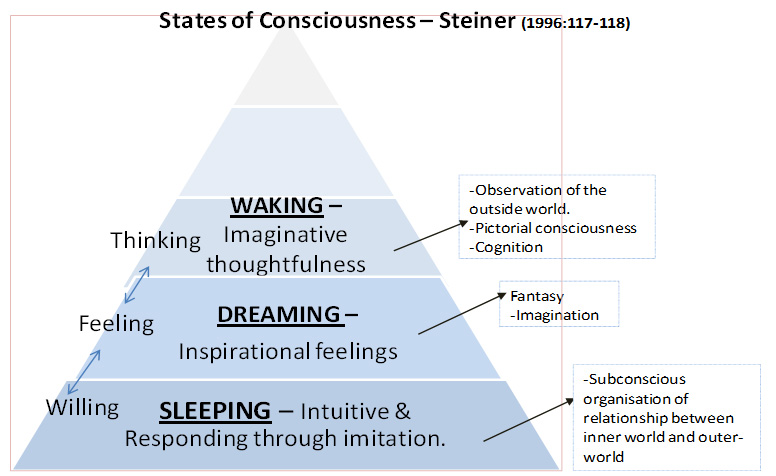
‘Perception of art and beauty…..The most highly developed form of sense perception’(Bredin,2000:3)

Contents
Defining Creativity
- Creativity in Practise
A definition of creativity
- Freedom to Play and Learn
- Aspects of Our Physical Form
- How We Perceive Colour
Colourpuncture – Peter Mandel
Aura Soma Healing Oils – Vicky Walls
- Different levels of human consciousness as different frequencies of light
- States of Consciousness – Steiner (1996:117-118)
Steiner’s Recommendations to Teachers
Conclusion
- Balancing the Wheel of Life…
Creativity is like the wind:
- Embrace contrast
- So the pendulum has swung
Defining Creativity
Duffy describes creativity as ‘connecting the previously unconnected in ways that are new and meaningful to the individual concerned’ and suggests that ’play promotes the flexibility and problem solving skills that are needed to be creative.’(Duffy,2006:8,23)
She describes the role of the adult as that of creating conditions which inspire children to be creative and imaginative through a commitment to the cycle of practical application she describes as : ‘implementing, observing, recording, assessing, planning.’ (Duffy,2006: 132)
Duffy also emphasises that adult interactions should:-
- embrace sensitivity and authenticity(Duffy,2006:94-95)
- recognise that the actual process ‘is often more important in encouraging creativity than the solution or end product’.(Fisher,1990:39)
- appreciate the child’s social desires to ‘represent and communicate his experiences’. (Duffy,2006:94-95)
Bernard defines creativity as ‘a search for new meanings and solutions that combine, invent and synthesise.’ He also presents ‘the essence of creativity is to be unpredictable’ and therefore suggests that it is ‘contradictory to describe what can be done to encourage it’ and that the organisation of materials and activities to support children’s creative development within the classroom cannot be prescribed. (Bernard,1965:75,92)
He suggests ‘the creative person is divergent and adventuresome’ and ‘the teacher must be competent and confident’ enough to ‘allow pupils freedom’ so that through her own ‘personality and resourcefulness’ and her own ‘unique combination of experience, interests, perceptions and attitudes’ she can foster creativity within the social and cultural context of the classroom. (Bernard,1965: 75,94,474,92)
Fisher suggests that creativity is derived from the disposition ‘to be curious, to wonder and to question.’ (Fisher,1990:3) He illustrates this in the diagram below:-



Hughes, suggests there is an association between play, creativity and problem solving. He describes play as ‘intrinsically motivated’- ‘freely chosen’ –‘pleasurable’ and for creative play he extends this definition to include: ‘imaginative’, ‘personality characteristic’, ‘an intellectual process’ with a ‘creative product’. Hughes goes on to describe divergent problem solving as ‘the ability to branch out from a starting point and consider a variety of possible solutions’ and that this is often linked to the processes involved in creative thinking and fantasy play. He describes intellectual flexibility as ‘a key ingredient in the creative process’ Hughes also suggests that using the imagination to direct external learning through play activities involves ‘decentration’ – ‘the ability to attend simultaneously to many features of one’s environment, to transform objects and situations while at the same time understanding their original identities and states, to imagine things as they are and also as they were’ (Hughes,1991:2,185-188) or could be. Piaget (1969) describes ‘decentering’ as prerequisite to the formation of operations relating to our physical, interpersonal and social cognitive constructions. (Piaget,1969:94-95)
Boden describes creativity as ‘unfamiliar combinations of familiar ideas ’ and suggests a ‘novel combination requires a rich store of knowledge.’ She associates creativity with play because both are ‘often open ended, with no particular goal or aim’ (Boden,2004:3,59)

Steiner relates creativity to something more than inspiration which he describes as ‘free thoughts and free will’. Through artistic activity one’s own creating gains ‘an objective existence’ that ‘lives in the world’ and presents a ‘spiritual point of view’ beyond the mechanics of the earthly world of reality -that which can be weighed, measured or counted. This engages ‘the whole significance of beauty and thus, establishes ‘real culture and real art’. When one surrenders one’s self to the freedom of being opened in one’s inner being, through association with ‘the artistic element’ and a ‘feeling for beauty’ the awakening state of spiritual consciousness ascends from ‘truth through beauty to goodness.’ (Steiner,1996a:171-173,181-183 &186.)
‘…..these are the kind of experiences mankind must have particularly through colour and sound but also through form; in fact altogether through the realm of art, in order to get away from the purely external relationships to things and their functioning….. and to penetrate into the inner secrets at the heart of things’ (Steiner,1996a:89)
Steiner describes artistic creativity as a bridge built between ‘abstract ideas of spiritual science and what flows from our hands, our chisel or our brush.’ He presents that through the ‘the living creativity of colour’ we are actually discovering what is in colour, in the same way as ‘the power of laughter is in someone who laughs’; and thereby ‘Etheric life fills our hearts and souls’ and we can :-
– celebrate our inner union with spiritual science -‘The soul element of nature’,
– and recognise ‘…the living connection between the flowing world of colour and the coloured objects and creatures around us.’ (Steiner,1996a:68-78)
Steiner suggests ‘the realm of art’ engages ‘the necessary power of perception’ and the discovery of ‘the nature of free flowing colour’ within the world of nature which initiates a ‘feeling for beauty’.(Steiner,1996a:189-196)
…..‘colours are a whole world and when the soul element experiences colour it feels it has come into movement.’ (Steiner,1996a:202)

Like colour, in a very similar way he describes musical tones – ‘the world of sound will enliven and deepen the life of soul’. Discovery of the secrets of the individual tones, ‘by going through the tone of the soul’, provides ‘a moral or spiritual quality’ of experience. (Steiner,1996a:87)
‘…. We have the same experience when we feel colour as we have in sound when we hear the tones of speech, here the world of sight and the world of sound penetrate into each other’. (Steiner, 1982: 39)
 ‘the real artistic value of poetry is not determined by verbal content’ so much as by the….. ‘musical element to be found in it.’…. ‘the artistic element, the rhythm, the metre and the inner form of the language used.’
‘the real artistic value of poetry is not determined by verbal content’ so much as by the….. ‘musical element to be found in it.’…. ‘the artistic element, the rhythm, the metre and the inner form of the language used.’
‘if we dived down….into our ego, taking with us what as yet can only be dimly felt of the Spirit-Self poetry is born’ (Steiner,2006:29)
The following diagramme illustrates Steiner’s description of the different aspects of our physical form and the corresponding relationship with the arts.
A Steiner definition of artistic creativity might have been: that which has been borne out of ‘human hearts which felt compelled to realise impulses coming from the spiritual world and to embody them in some way in the external matter.’ When what the soul feels releases itself from the human being as ‘artistic impulses’ unites with ‘the mighty creative forces of nature’ so that very much more grows out of the activity than ‘could originally have intended or foreseen’. This becomes ‘an instrument for the creative powers of the universe’, and turns to ‘sculptural formative activity with intuitive cognition’; an illuminating spark from the human Spiritual Self initiates itself through the ego as a physical embodiment of the astral and etheric bodies. (Steiner,2006:62-63,92)
Steiner presents the foundations for creative development (the child’s disposition of curiosity, discovery and creativity) during the early years 3 to 7 as: aesthetically pleasing surroundings constructed with natural materials, rhythmic repetition, artistic activities, imaginative play and a natural outside play area. (Steiner,1982)
Steiner presents that we receive the rich and varied world around us through colour. ‘We should enter the living world of nature and the experience of colour itself. ‘We must sink ourselves completely into what we receive through colour if we wish to penetrate into its true nature, bringing insight into our feelings.
How We Perceive Colour

![]()
Colourpuncture
Peter Mandel pioneered a therapy called Colourpuncture which combines the priciples of acupunture with the healing power of colour, using specified coloured torch light on acupuncture points. Colour Me Healing –Allanach,2002 cites the work of Mandel and describes the different colours used as follows:

Aura Soma Healing Oils
The late Vicky Walls, due to blindness, was dependent upon her psychic perception of aura colours, (the energetic body which surrounds all living entities.). She developed over 100 different colour healing products all made from natural resources. Scientific research has indicated that the cells of the body naturally communicate through frequencies of light. Each colour carries a particular light frequency which the cells of the body can easily absorb and transmit to facilitate balance and health.
Aura Soma Equilibrium Balance Healing Oils

A person’s unique relationship with colour is illustrated within their choice of clothes, decorative surroundings and outdoor garden landscaping. It is not just design but also colour, that motivate us to be especially attracted or pleased with particular aesthetic experiences.
Different Levels of Human Consciousness as Different Frequencies of Light
Ramtha (The beginners guide to Creating Reality 3rd Ed. Written by J Z Knight; JZK publishing,2004.)
Describes the different levels of human consciousness as different frequencies of light that can be seen as colours. This is described in his book as illustrated.

Steiner suggests that adults can express their unique, authentic individuality when supporting children’s creative activity without disrupting, over-riding or distracting the purity of the child’s chosen activities of creative expression. As adults we can focus not only on what we are doing but also those unique qualities which make us who we are as individuals.
‘Feeling lies in the middle between thinking and willing, so that feeling connects with thinking in one direction and willing in the other.’

‘….for the subjective human soul to be convinced of the correctness of a judgment, feeling must develop.’
‘A need for imagination, a sense for truth, and a feeling for responsibility.’
(Steiner, 1996:42,99,101,212)
Steiner related human development to the development of consciousness which he described in the diagram below:-

Steiner’s Recommendations to Teachers
In the following list the author summarizes some of Steiner’s recommendations to teachers:-
- Not to underestimate the strength of the human subconscious to strive to do things better. (Steiner1996:86)
- Observe and accommodate the uniqueness of the individual child.(Steiner,1982:32)
- Aspires to provide an aesthetically pleasing and joyful (Steiner1996:157-8) environment:-
- living in beauty, that powerfully awakens the child’s creative imagination (Steiner,1996a:46)
- cognitive activity that occurs in thinking, feeling and willing. (Steiner1996:106-7)
‘……. Feeling lies in the middle between thinking and willing, so that feeling connects with thinking in one direction and willing in the other.’ (Steiner1996:99) ….‘for the subjective human soul to be convinced of the correctness of a judgment, feeling must develop.’ (Steiner1996:101)
- Acknowledges the importance of repetitive activity Steiner suggests that ‘repetitive activity’…. ‘allowing the child to do something today, tomorrow and the next day’ has an influence on the child’s willing and feeling. The child’s devotion to repetition developments unconsciously and cultivates his feelings, ‘conscious repetition cultivates the will impulse because through it (repetition) the power of decision increases. Modern people have been trained for one time experiences……..cultivation of the will is based in unconscious repetition.’….. (Steiner1996:92-93) The physical expression of ‘…thinking and willing……flow together in cognitive or reflective activity.’ (Steiner1996:79&97)
- Encourage discovery of the ‘beautiful laws of nature’ (Steiner1996a:66) and associated perceptions of the divine source –the flower opening, lambs playing in the fields, the dawn chorus of birds song, the infinity of movement in the flowing stream.
- Acknowledge the importance of ‘observing things as we experience them’(Steiner1996:78) – (cognitive activity illuminated with thinking. (Steiner1996:99)
- An ‘unpretentious’ (Steiner1996:43)disposition. A balanced engagement with a sense of immediacy and patience, freedom and necessity. (Steiner,1988:63) ‘….the most important things in teaching and education are those that are imponderable.’ (Steiner,1982:12)
- Teach by example as an apprentice to her own celebration of beauty and creative expression, problem solving and divergent thinking, curiosity and discovery, and openly engaging her personality and spiritual qualities.
- Connect an ‘artistic element’ with every aspect of teaching in order to awaken unconsciously inspired imagination which is experienced as pictures/images and feelings related to artistic creativity. ‘What people receive through artistic activity always gives them joy’ (Steiner1996:93) and in their innocent and soulful state of being, children subconsciously assume ‘that the world is beautiful.’ (Steiner1996:157)
- Create an environment supportive of discovery and creativity that supports the child’s natural and unconventional styles and approaches to learning, often without a notable end-product.
- Provide a supportive environment based on observation of the children’s chosen activities, interests and ideas, imaginations and dreams.
- Create an environment of discovery, supporting the processes of play within learning rather than the success of production. Encourage ‘will’ based activity that is motivated by ‘pure sense-free thinking’ (Steiner1996:68) i.e. independent of the external stimulus, and gives rise to levels of comprehension fundamental to human intellectual activity motivated by the will.
- Embrace ‘the life of the soul’ and acknowledge that ‘the human being is not simply an observer of the world.’ (Steiner1996:77) The subtle influence between the human soul and the ‘will’ transforms desires into motives with a strong inner incentive and subsequent intellectual development of comprehension and consciousness. (Steiner1996:86)
- Meet the child’s requests for adult participation from a genuine disposition and desire to share without presenting solutions and/or superior skills that disempower the child’s direct (conscious) or indirect (subconscious) motives, desires and learning processes.
- Acknowledge ‘that an inner spiritual relationship exists between the teacher and the children.’ (Steiner1996:44)
- Establish ‘Balance in Teaching’(Steiner,1982) as an art that ‘must be invented at every moment’.(Steiner,1982:32) Teachers should be more than ’simply educators’ and have a ‘living interest’ …….’enthusiasm and devotion to everything happening today’ (Steiner, 1996:31)
‘In the practice of teaching there will awaken in us, out of this knowledge of human nature, the art of education in a quite individual form. ’In teaching and education there is a curious interweaving of two different elements, the musical, tonal element in the world that we hear, and the pictorial in the world that we see.’ (Steiner, 1982: 32)
Conclusion
The author proposes that children’s creative activity is illustrated by the quality of creativity within the adults engagement with a sense of movement and balance within the individual child/ren and the social and cultural context of the relationships:-

Creativity is like the wind:
- The affects can be seen and felt.
- It can be channelled to create a physical influence, g. the flying kite or the wind turbine.
Yet, in itself it remains an undefinable representation of creative freedom.
The art of learning is as colourful and as unique as each individual adult and child, and the moment by moment unfolding of each new opportunity.
Supportive adult practice may need to include an ability to spot ‘the emergent beginnings’ of creativity (Bruce,2004:135) within play and learning and respond creatively with uniquely appropriate support and encouragement.
If creativity is an open ended exploration that invites us to move on – expand into new perspectives and boldly embrace new opportunities, any conclusion would be detrimental to the very nature of the subject ‘CREATIVITY’.
The demonstration described below may in some way illustrating the nature of creativity and commonly associated aspects of consequences, entertainment and primitive responses to strong stimulus:-
The balloon represents the environment, the air in the balloon represents the abstract creative element, and the balloon’s responses represent the visible relationship with creativity. Creativity is like the air we breathe, it is fundamental to our state of living as humans, it is abundant in every aspect of our environment and yet it has no tangible form. Just as it can be caught in a balloon, creativity can be expressed through the results of creative activity although it cannot in itself be held or seen, it can only be felt within a spiritual context and like the wind its presence, and its influence upon our environment and our own individual disposition can be appreciated.
Creativity is like the air we breathe, it is fundamental to our state of living as humans, it is abundant in every aspect of our environment and yet it has no tangible form. Just as it can be caught in a balloon, creativity can be expressed through the results of creative activity although it cannot in itself be held or seen, it can only be felt within a spiritual context and like the wind its presence, and its influence upon our environment and our own individual disposition can be appreciated.
| Embrace contrast at the outermost points of our reality with an overall feeling for the harmony at the centre. |
There is more power in creativity than any form of control, and more creativity in love than in any form of personal interaction. Every person in every situation needs to apply their own creativity to peaceful solutions with the same power and determination as a mother would protect her young child. Only when we empower ourselves and our children to develop their true powers of creativity will the distress in our world be beaten forever. The question is not ‘Can we resolve every challenging situation with creatively peaceful solutions?’ but ‘How to resolve every challenging situation with creatively peaceful solutions?’
So the pendulum has swung
A new dimension has begun,
Free from adversity
Bathed in sweet synchronicity.
Where every freedom has the flavour of goodness
And every moment has the fragrance of sweetness.
Positive ways forward are now present and highly favoured
If we work to change the environment not the behaviour.
The true potency of love can offer peaceful alternatives.
All we need to do is learn to see them and use them from the heart.
If this is our wish so it will be,
Bibliography
Bhakitivedanta Narayana Maharaja translated from Hindi, Sri Brahma-samhita 5th Chapter. Vrndavana; Gaudia Vidanta Publications, 2003.
Bhaktivedanta Narayana at Badger California : June 18th, 2005. Giving a discourse on the book Sri Bhagavata Arka Maricimala by Srila Bhaktivinoda Thakura.
Bhaktividanta Swami Prubhupada A.C. KRISNA. New York: Bhaktividanta Book Trust, 2002.
Bradburn, E. Margaret McMillan. Redhill; Denholm House, 1976.
Ceppi, G. & Zini, M. Eds, Children, Spaces, Relations, Reggio Emilia: Reggio Children, 1998.
Danks, F. & Schofield, J. Natures Playground. London; Francis Lincoln, 2005.
Department for Children, Education, Lifelong Learning Skills; Framework for Children’s Learning for3 to 7-year-olds in Wales. Cardiff; Welsh Assembly Government, 2008.
Doman, G. What to do about your Brain Injured Child. New York;Doubleday and Company,1960.
Einarsdottir, J. & Waagner, J. T. Eds. Nordic Childhood and Early Education. Conneticut; Information Age, 2006.
Elass, M.The true Seeker (Booklet). International Bible Society, 1997.
Fisher, R. Teaching children to think. Oxford; Blackwell, 1990.
Garrick, R Playing Outdoors in the Early Years. London; Continuum,2004.
Goddard-Blythe, S. The Well Balanced Child. Stroud; Hawthorn Press, 2004.
Goldschmied, E. & Jackson, S. People Under Three 2nd Ed. London; Routledge, 1994/2004.
Gurian, M. Boys and Girls Learn Differently. USA; Jossey-Bass, 2001.
Harrison, S. The Happy Child. Colorado; Sentient, 2002.
Hochswender, W. Martin,G. & Morino, T. The Buddha in your Mirror. USA; Middleway Press, 2001.
Honore, C. In Praise of SLOW. London; Orion, 2004.
International Froebel’s Society conference july2004, programme of events and abstracts of presentations and workshops. Froebel college or university of Surrey roehampton.
Khalsa, D. S. The Mind Miricle. London; Arrow Books,1997.
Knight, S. Forest of schools and outdoor learning in the Early Years. London; Sage, 2009.
Louv, R. Last Child in the Woods. North Carolina; Algonquin Books, 2006.
Mac Naughton, G. Shaping Early Childhood. Maidenhead; Open University press, 2003.
MacMillan, L. Creating Outdoor Classrooms. USA; University of Texas Press, 2008.
Meadows, S. The Child as Thinker 2nd Ed. London; Routledge, 2006.
Megre, V. The energy of Life.USA; Ringing Cedars Press, 2003.
Montessori, M. The Absorbent Mind. Oxford; Clio Press, 1988.
Montessori, M. The Discovery of the Child. New York; The Random House, 1967.
Moyles, J. Ed. Early Years Foundations Maidenhead Open University Press, 2007.
O’Brian, L & Murray, R. Forest School and its impacts on young children: Case studies in Britain. Elsevier/Urban Forest &Urban Greening. No. 6, 2007. www.sciencedirect.com
O’Brian, L. Trees and Woodlands: Nature’s Health Service. Farnham; Forestry Commission, 2005.
Ouvry, M. Exercising muscles and minds. London; National Children’s Bureau, 2003.
Palmer, J.D. Animal Wisdom. London; Element, 2001
Purnaprajna Das. Shri Chatanya Charitamrita. Maharashtra (India): Bhaktiratna Sadnu Swami, 2002.
Scotson, L. Doran, Child of Courage. London; Pan Books, 1985.
Sims N. Ed. The Brain and Central Nervous System. London; The Readers Digest Association,2000.
Steiner, R. Truth and knowledge 2nd Ed. London; Rudolph Steiner Publications, 1981.
Steiner, R. Necessity and Freedom. London; Anthroposophic Press, 1988.
Steiner, R. The roots Of Education. London; Anthroposophic Press, 1997.
Steiner, Rudolf. Child’s Changing Consciousness & Waldorf Education. New York: Anthroposophical Press, 1988a.
Steiner, Rudolph. Balance in teaching. New York : Mercury Press, 1982
Steiner,R. The Essentials of Education. USA; Anthroposophic Press, 1997a.
Taylor, J. My Stroke of Insight. London: Hodder & Stoughton,2009.
Vander, A., Sherman, J. & Luciano, D. Human Physiology 8th Ed. New York; McGraw-Hill, 2001.
